Exploring the Benefits of Nature-Based Solutions in Urban Planning
Understanding Nature-Based Solutions
In recent years, the concept of nature-based solutions (NBS) has gained significant traction in urban planning. These strategies utilize natural processes and ecosystems to address urban challenges, such as climate change, urban heat, and biodiversity loss. By integrating natural elements into city landscapes, planners aim to create more sustainable, resilient, and livable urban environments.
Nature-based solutions encompass a wide array of practices, including green roofs, urban forests, and restored wetlands. These approaches offer multifaceted benefits that go beyond environmental improvements, addressing social and economic aspects as well.

Environmental Benefits of Nature-Based Solutions
A primary advantage of implementing NBS in urban settings is their ability to mitigate climate change impacts. Urban areas often face issues such as increased temperatures and flooding due to the concentration of impervious surfaces. NBS can help to counteract these effects by enhancing natural water management and reducing heat through increased vegetation.
Moreover, green spaces contribute to improved air quality by filtering pollutants and sequestering carbon dioxide. This can result in healthier urban environments and contribute to the overall well-being of residents.
Enhancing Biodiversity
Urban areas are typically characterized by reduced biodiversity due to habitat loss and fragmentation. Nature-based solutions aim to reverse this trend by creating habitats for local flora and fauna. Urban parks, green corridors, and community gardens serve as vital refuges for wildlife, promoting biodiversity within cities.

Social and Economic Advantages
Beyond environmental gains, nature-based solutions offer substantial social benefits. Green spaces provide recreational opportunities and serve as communal areas where residents can connect with nature and each other. These interactions can enhance community cohesion and improve mental health by reducing stress and promoting physical activity.
Economically, NBS can be cost-effective alternatives to traditional infrastructure. They often require less maintenance over time and can increase property values by making neighborhoods more attractive. Additionally, these solutions can create green jobs in areas such as landscape design, horticulture, and ecosystem management.
Improving Urban Resilience
The integration of nature-based solutions also plays a crucial role in enhancing urban resilience. By buffering against extreme weather events, such as heavy rainfall or heatwaves, NBS contribute to a city's capacity to adapt to climate change. This resilience ensures that urban areas remain functional and safe for inhabitants during adverse conditions.

Implementing Nature-Based Solutions in Urban Planning
To effectively incorporate NBS into urban planning, collaboration among city planners, environmental scientists, policymakers, and the community is essential. This collaborative approach ensures that the solutions are tailored to the specific needs and characteristics of each urban area.
Public awareness and education are also critical components in promoting the adoption of nature-based solutions. By highlighting their benefits, cities can encourage residents to support and participate in green initiatives.
The Future of Urban Environments
The growing interest in nature-based solutions signifies a shift towards more holistic urban planning strategies that prioritize environmental sustainability alongside socio-economic development. As cities continue to expand and face mounting challenges from climate change, embracing NBS will be vital in creating cities that are not only sustainable but also vibrant places for people to live and thrive.

